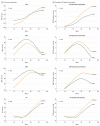Sex Differences in Blood Pressure Trajectories Over the Life Course
- PMID: 31940010
- PMCID: PMC6990675
- DOI: 10.1001/jamacardio.2019.5306
Sex Differences in Blood Pressure Trajectories Over the Life Course
Erratum in
-
Error in Author Affiliation.JAMA Cardiol. 2020 Mar 1;5(3):364. doi: 10.1001/jamacardio.2020.0173. JAMA Cardiol. 2020. PMID: 32186678 Free PMC article. No abstract available.
Abstract
Importance: If we assume that women and men exhibit variations of the same fundamental vascular physiology, then conventional analyses of subclinical measures would suggest that women catch up to men by midlife in the extent of potentially important vascular disease. Alternatively, under the assumption that vascular physiology may fundamentally differ between women and men, a sex-specific analysis of existing data could offer new insights and augment our understanding of sex differences in cardiovascular diseases.
Objective: To evaluate whether longitudinal patterns of blood pressure (BP) elevation differ between women and men during the life course when considering baseline BP levels as the reference.
Design, setting, and participants: We conducted sex-specific analyses of longitudinal BP measures (144 599 observations) collected for a period of 43 years (1971 to 2014) in 4 community-based US cohort studies. The combined total included 32 833 participants (54% female) spanning ages 5 to 98 years. Data were analyzed between May 4, 2019, and August 5, 2019.
Exposures: Age and serially assessed longitudinal BP measures: systolic BP, diastolic BP, mean arterial pressure (MAP), and pulse pressure (PP).
Main outcomes and measures: Sex-specific change in each primary BP measure compared with baseline BP levels, derived from multilevel longitudinal models fitted over the age span, and new-onset cardiovascular disease events.
Results: Of the 32 833 participants, 17 733 were women (54%). Women compared with men exhibited a steeper increase in BP that began as early as in the third decade and continued through the life course (likelihood ratio test χ2 = 531 for systolic BP; χ2 = 123 for diastolic BP; χ2 = 325 for MAP; and χ2 = 572 for PP; P for all <.001). After adjustment for multiple cardiovascular disease risk factors, these between-sex differences in all BP trajectories persisted (likelihood ratio test χ2 = 314 for systolic BP; χ2 = 31 for diastolic BP; χ2 = 129 for MAP; and χ2 = 485 for PP; P for all <.001).
Conclusions and relevance: In contrast with the notion that important vascular disease processes in women lag behind men by 10 to 20 years, sex-specific analyses indicate that BP measures actually progress more rapidly in women than in men, beginning early in life. This early-onset sexual dimorphism may set the stage for later-life cardiovascular diseases that tend to present differently, not simply later, in women compared with men.
Conflict of interest statement
Figures




Comment in
-
Adverse Cardiovascular Outcomes for Women-Biology, Bias, or Both?JAMA Cardiol. 2020 Mar 1;5(3):27-28. doi: 10.1001/jamacardio.2019.5576. JAMA Cardiol. 2020. PMID: 31940008 No abstract available.
References
Publication types
MeSH terms
Grants and funding
LinkOut - more resources
Full Text Sources
Other Literature Sources
Medical
Miscellaneous

